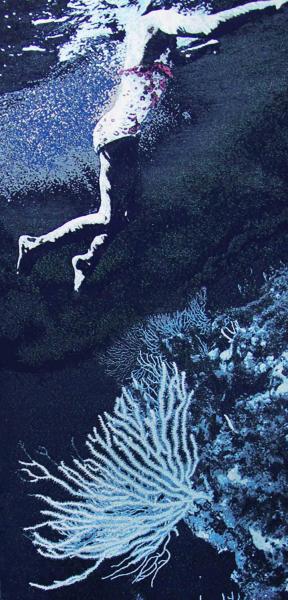Bain de minuit (coraux), 2013
Original tapestry (mohair, lurex, phosphorescent threads). N°3/5
270 x 130 cm
THAT EVERYTHING IS TRANSFORMED
Originally from Marseille, Laurence Aëgerter divides her time between her native city and Amsterdam, her adopted home where she first went to study art history in the early 2000s.
Fascinated by the image and its metamorphoses, the artist invites us to look differently, to overturn perspectives and the established orders of our perception, blurring the lines between the signified and its signifier. Time and place interact and merge to reveal mysteries great and small, and the images are revealed in layers, each inviting further hypotheses of understanding and interpretation. From enigma to enigma, the viewer is caught up in an immense game of clues and correspondences, which is in a way the common thread running through his work.
Drawing on the universal archives of photography and art history, as well as her own photographs, Laurence Aëgerter's work is skilfully thought through, but retains an instinctive, almost childlike naivety that makes it accessible and touching. Where erudition does not erect barriers, but instead builds bridges between times and worlds. Museums and books become living supports.
The artist questions the elementary substance of the image, which abounds in our contemporary society, by calling on a multitude of techniques, both artistic and artisanal, to support his research. Photography first and foremost, but also tapestry, ceramics, glass, cutting, collage, collecting... everything can be used by Laurence Aëgerter, everything can be transformed and everything can be communicated with joy.
Plastic solutions are infinite: the phosphorescent powder that poetically coats glass, which she experimented with at the CIRVA (Centre international de recherche sur le verre et les arts plastiques) in Marseille, giving rise to Moirai - Lucioles des Mers; plant poultices as a healing ritual invented on photographs of wounded landscapes... She even resurrects almost-forgotten techniques such as lithophane, which she implements in the workshops of the Musée de Sèvres, creating a thin translucent ceramic plate from an enlarged daguerreotype, on whose surface light alone, coming from the reverse side of the piece, sculpts the image so as to make it visible. This delicate work, which focuses on the sleep of a small child, was presented as part of the exhibition devoted to the artist at the end of 2020 at the Petit Palais, Ici mieux qu'en face, during which Laurence Aëgerter wove links between the ancient pieces in the museum's collection and our own temporality.
We were particularly keen to present the Longo Maï tapestry series at Reine Jeanne, which, based on an anonymous photographic archive drawn from the web, offers a plunge beneath the waters of the Mediterranean. What lies beneath the calanque, beneath the emerging heads of the bathers, is revealed to us, inverting the usual order of our understanding. Legs flail to the surface, but nothing of earthly life can be discerned. What these tapestries show us is the hidden, the secret of another world, a reality that perceives only headless bodies. A depth, a mystery. The verticality of the works immerses us, plunging us intensely into a maritime, floating universe, where bodies are weightless. A double-bottomed drawer, one secret hides another. The artist has woven her bathers from phosphorescent threads. Drawing on light by day, the bodies gleam sumptuously at night. Behind a mask, in apnea, lurking near the coral reefs, hidden from view, the amazed child holds his breath for as long as possible. Longo Maï: as long as it lasts...
Laurence Aëgerter's works are held in numerous public collections in France and abroad, including the Bibliothèque Nationale de France, the Musée Borély des Arts décoratifs et de la mode, the MAMAC in Nice, the Manufacture de Sèvres, the New York Public Library, the Paul Getty Research Center Institute in Los Angeles, the Spencer Museum of Art in Kansas, the Museum van Loon in Amsterdam, the Museum Voorlinden in Wassenaar, the Fotomuseum in Rotterdam, the Museum Het Dolhuys, Museum of Psychiatry and the Mind in Haarlem, the Fries Museum in Leeuwarden... This set of four tapestries, Longo Maï, is part of the permanent collection of the Musée des Arts décoratifs, de la Faïence et de la Mode in Marseille. It can be seen on the walls of the Grand Salon at Château Borély, in a space dedicated to contemporary creation and design.

